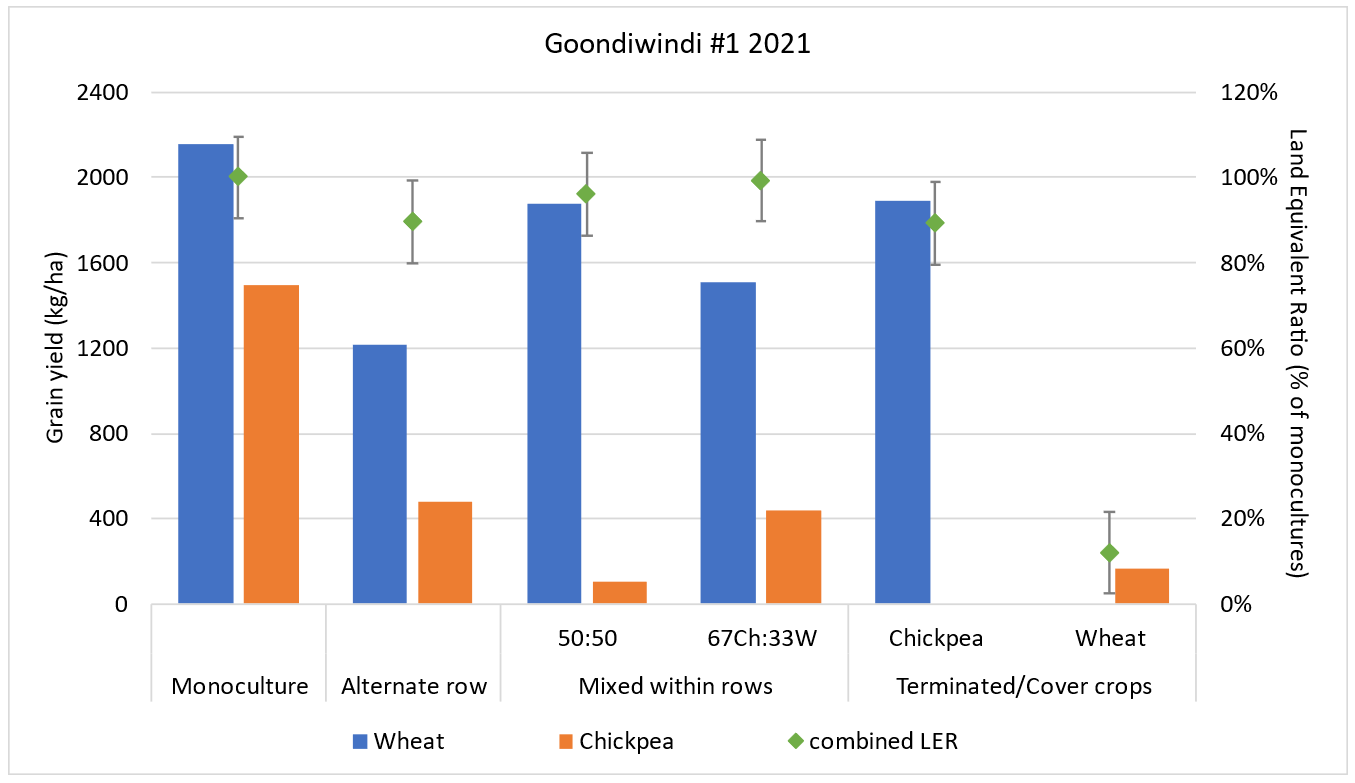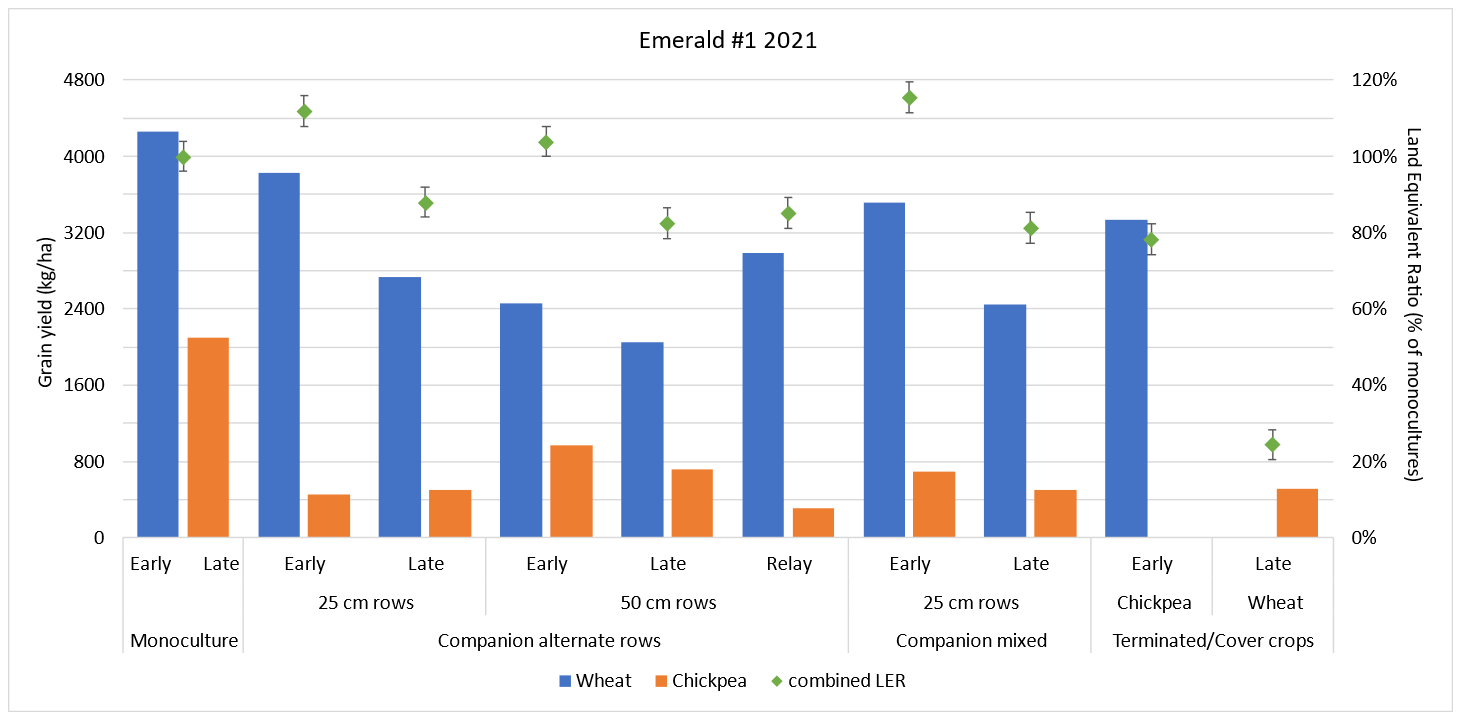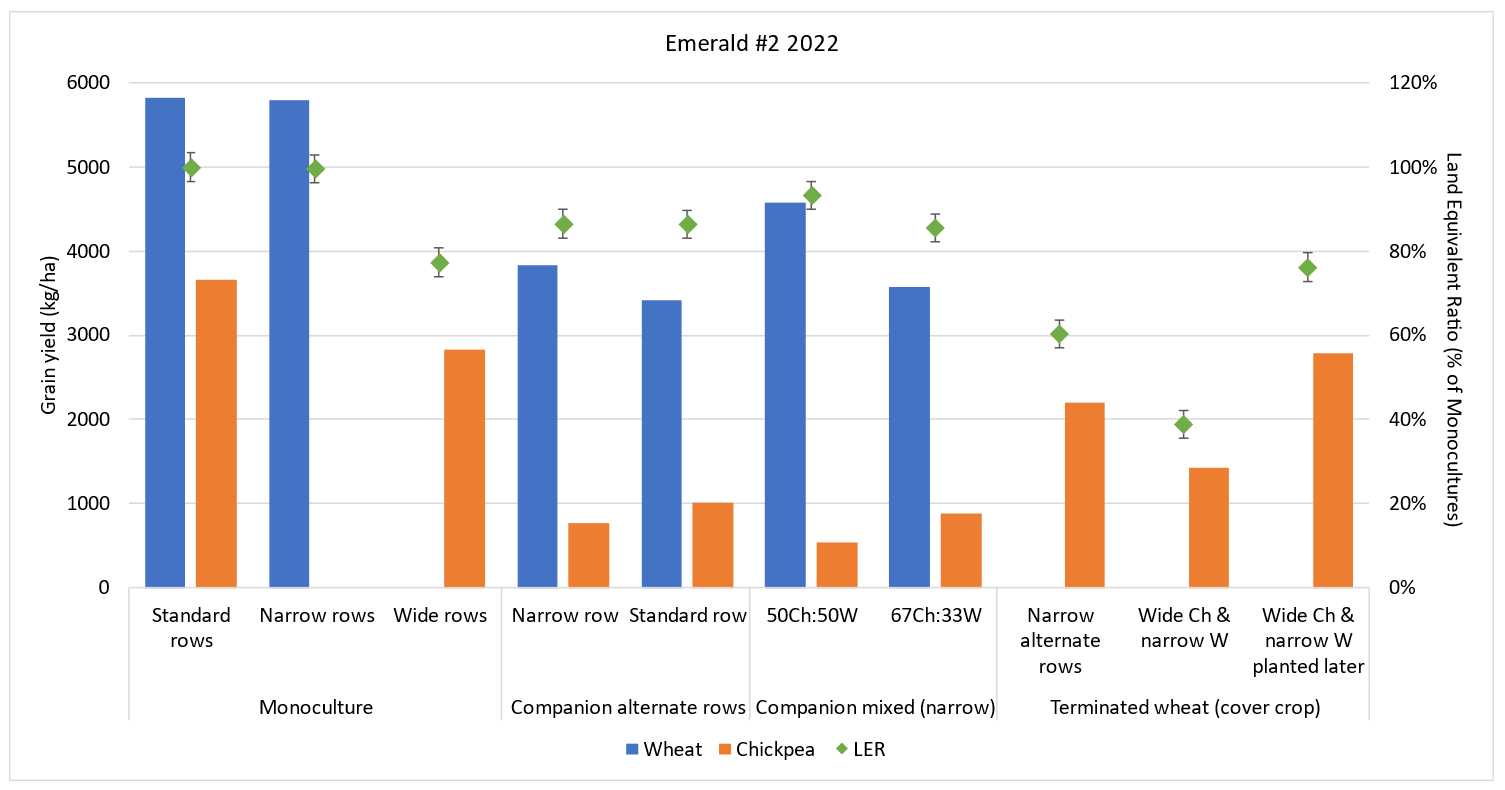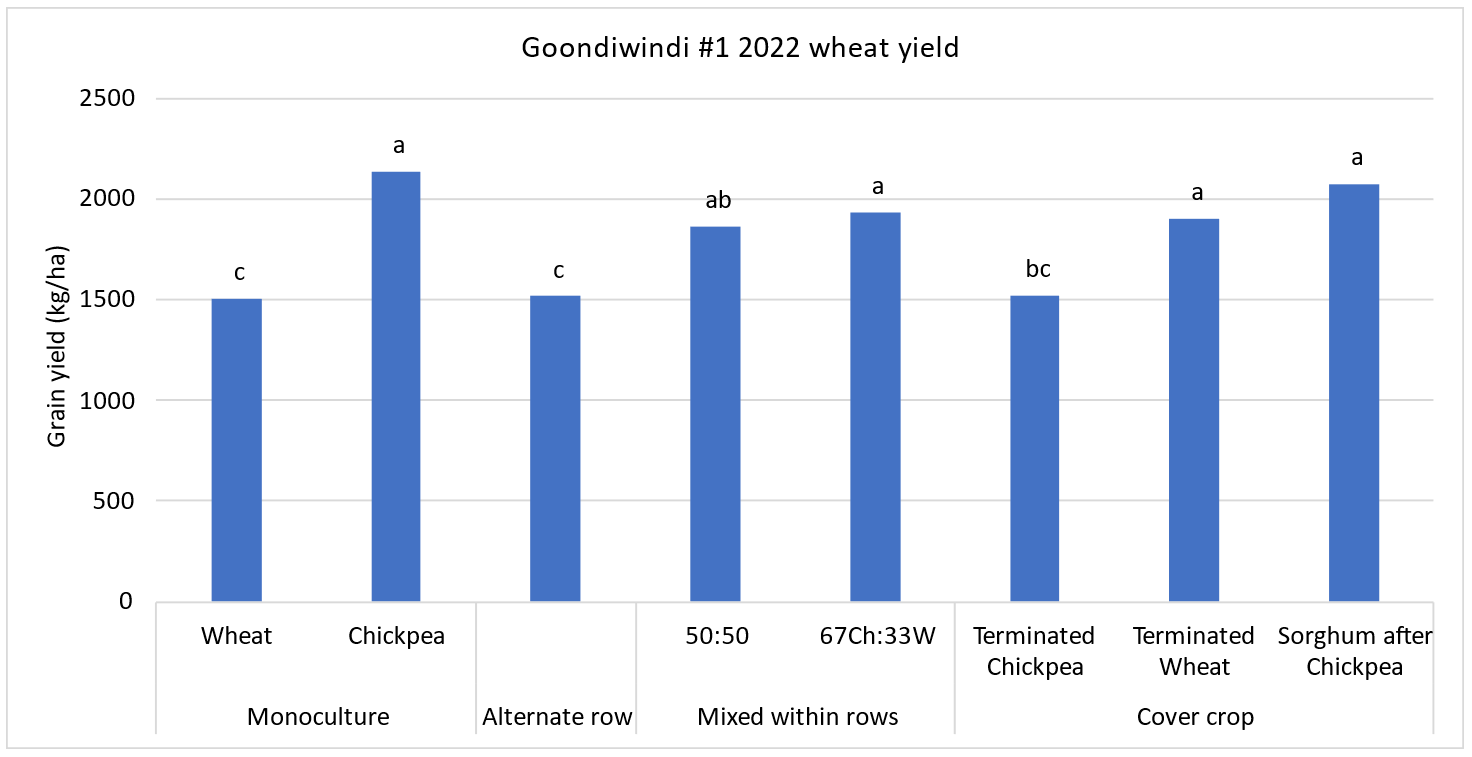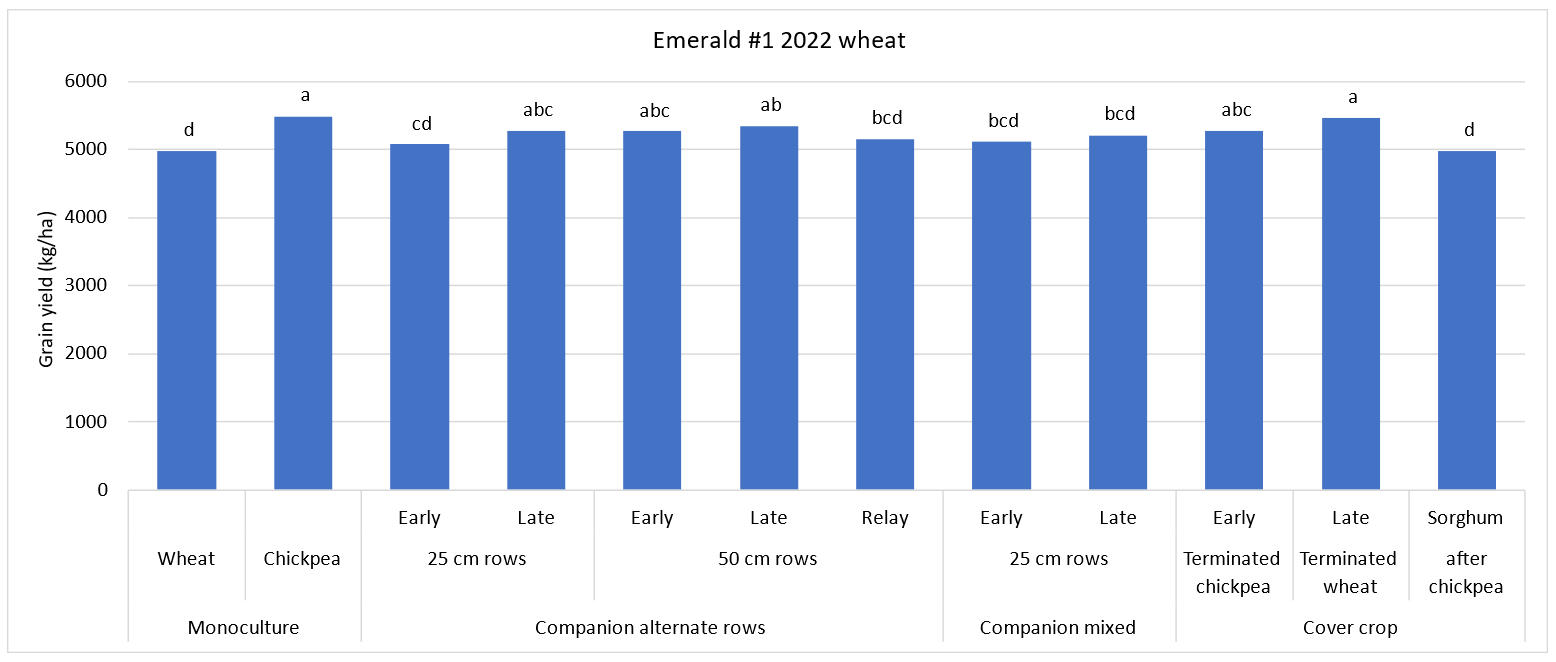Companion cropping wheat with chickpea to improve fallow efficiency
Companion cropping wheat with chickpea to improve fallow efficiency
Author: Andrew Erbacher (DAF Qld), Doug Sands (DAF Qld) | Date: 28 Feb 2023
Take home message
- Wheat and chickpea can be grown as companion crops without a yield penalty in Queensland farming systems reliant on stored soil water for grain yield
- Planting rates and row spacings need to be adjusted to manage crop competition by the more competitive partner (wheat).
Background
It is widely accepted that chickpeas are well suited to Queensland growing conditions and as a result generate significant gross margins for our grain growers. Their popularity is stymied by the fact that the residual stubble of this crop is sparse and leaves the soil quite bare. This bare soil then reduces our fallow efficiency (amount of fallow rainfall captured and stored for use by the next crop), which is a big problem in an area that relies on stored soil water for yield.
The DAF research agronomy team recently completed a study growing cover crops in the fallow to improve ground cover and soil water available for the next crop. That study highlighted the value of ground cover in the system. As an extension of this work, the companion cropping concept extends the opportunity to grow a cover crop alongside our chickpeas.
The idea of companion crops or intercropping is not new or novel. Companion crops are found in every home vegetable garden; from marigolds to keep the pests out of tomatoes, or flowers to attract pollinators into the pumpkin patch. What is novel is applying this concept on a broadacre scale and with mechanically harvested crops.
A recent review of Australian intercropping research (Roberts et al 2022) showed potential to increase crop productivity. They found cereal-legume intercrops increase productivity by an average of 14%, and pea-canola increased productivity by an average of 31%.
Similarly, Fletcher et al (2016) showed potential to increase crop productivity with intercrops; particularly with ‘peaola’ (canola and field pea), which increase productivity by 50% in 24 of 34 studies reviewed. They also found cereal-legume intercrops to increase productivity in 64% of studies.
The studies in these reviews were from temperate cropping areas of southern Australia and internationally, so the question remains whether these systems will perform in a sub-tropical environment and a farming system reliant on stored soil water for yield stability.
We focused our efforts on wheat and chickpea given our reliance on stored soil water for maintaining grain yield and the fallow efficiency cost of low stubble cover following chickpea.
The research question was two-fold:
- Can we increase stubble cover after chickpea?
- What is the yield impact of growing wheat and chickpea together as companion crops?
What was done
Our objective of increasing ground cover after chickpeas was discussed with growers and agronomists at both Goondiwindi and Emerald and treatments (Table 1) were developed for each site. The challenge of growing these two crops so that the more competitive (wheat) crop doesn’t dominate, was discussed at length.
The Emerald group also identified a four-week difference in the ideal planting windows for wheat and chickpea. Two plantings were used where an ‘early’ planting favoured the wheat and a ‘late’ planting favoured the chickpeas. Companion crops were then duplicated to match both of these planting dates as well as a relay planting treatment where the chickpea was planted between established wheat rows.
Cover crop treatments were also planted at these sites as another approach to improving ground cover after chickpea. Cover crop treatments were either traditional cereal cover crops in the fallow, or companion planted wheat and chickpea with one crop being sprayed-out prior to flowering.
Both sites had wheat planted across the whole site in the following winter season (2022) to measure yield impacts of the different cropping systems.
Treatments were reviewed and a second companion crop trial was planted in the 2022 winter growing season (Table 2).
Table 1. 2021 companion cropping treatments at Emerald and Goondiwindi.
Emerald | Goondiwindi | |
|---|---|---|
1 | Wheat (control) (early) | Wheat (control) |
2 | Chickpea (control) (late) | Chickpea (control) |
3 | Chickpea followed by a cover crop | Chickpea followed by a cover crop |
4 | Early chickpea/wheat mixed, spray out chickpea | Chickpea/wheat mixed, spray out chickpea |
5 | Late chickpea/wheat mixed, spray out wheat | Chickpea/wheat mixed, spray out wheat |
6 | Early wheat/chickpea alternate row 25 cm | Chickpea/wheat, alternate rows |
7 | Early wheat/chickpea alternate row 50 cm | Chickpea/wheat, mixed within rows, 50:50 |
8 | Early wheat/chickpea mixed within rows 25 cm | Chickpea/wheat, mixed within rows, 67:33 |
9 | Wheat/chickpea relay cropped | |
10 | Late wheat/chickpea alternate row 25 cm | |
11 | Late wheat/chickpea alternate row 50 cm | |
12 | Late wheat/chickpea mixed within rows 25 cm |
Table 2. 2022 companion cropping treatments at Emerald and Goondiwindi.
Emerald | Goondiwindi | |
|---|---|---|
1 | Wheat (control) 50 cm | Wheat (control) |
2 | Wheat, narrow rows (25 cm) | Chickpea (control) |
3 | Chickpea (control) 50 cm | Chickpea followed by a cover crop |
4 | Chickpea, wide rows (100 cm) | Chickpea/wheat, narrow alternate row, spray out chickpea |
5 | Chickpea followed by a cover crop | Chickpea/wheat, narrow alternate row, spray out wheat |
6 | Chickpea/wheat, narrow alternate rows, | Chickpea/wheat, narrow alternate row, spray out wheat earlier. |
7 | Chickpea/wheat, narrow row; 3 wheat: 1 chickpea, spray out wheat | Chickpea/wheat, alternate rows |
8 | Chickpea/wheat, relay cover: wide chickpea, with narrow wheat on next rain, spray out wheat | Chickpea/wheat, narrow alternate rows |
9 | Chickpea/wheat, alternate rows | Chickpea/wheat, mixed within rows, 50:50 |
10 | Chickpea/wheat, narrow alternate rows | Chickpea/wheat, mixed within rows, 67:33 |
11 | Chickpea/wheat, mixed within narrow rows, 50:50 | Chickpea/wheat, mixed within rows, 80:20 |
12 | Chickpea/wheat, mixed within narrow rows, 67:33 | Chickpea/wheat, mixed within rows, 90:10 |
Standard row spacing was 50 cm at Emerald and 30 cm in Goondiwindi. For ‘narrow rows’ the inter-row fertiliser unit was used at both sites (25 cm Emerald and 15 cm in Goondiwindi). This gives us a commercial comparison to wheat and chickpea in separate boxes of the air-seeder plumbed to deliver seed to alternate rows (alternate row treatments); planting one crop, then nudging GPS and planting the second crop between the rows as a second pass (narrow alternate rows); and mixing the seeds in the same seed-box (mixed within rows).
Each species tested in the companion configuration was grown as a monoculture at the same time as a baseline yield comparison. These monoculture treatments were planted at standard commercial rates (1 million plants per hectare for wheat and 250,000 plants per hectare for chickpea). The ‘cover crop’ treatments were planted at a full rate of each crop, so the harvested population was the same as the monoculture treatments.
The companion treatments where both crops were harvested together had planting rates reduced to reflect a normal plant density. For alternate row treatments the in-row population was the same as the monoculture controls. The ‘mixed’ treatments were mixed in proportion to recommended planting rates. For example, ‘mixed 50:50’ had 500,000 wheat plus 125,000 chickpea plants per hectare spread evenly across all rows.
In the ‘cover crop’ treatments, one species was terminated (sprayed-out) before flowering occurred with herbicides registered for in-crop weed control in wheat or chickpea.
The monoculture crops will have different yield potentials, so it would be expected that combined yields of companion crops will be between the two monoculture crops being compared. In that situation it would be difficult to assess whether a benefit/penalty was achieved. Therefore, the crop yields were converted to a percentage of the monoculture crop, then they can be added together. This combined percentage is called a land equivalent ratio (LER). An LER of 100% (i.e., 60% wheat + 40% chickpea) suggests the same grain yield would have been achieved by splitting the area planted into separate paddocks of monocultures. An LER of 80% would mean there was antagonism between the crops resulting in a 20% reduction in yield, whereas our hope is to achieve an LER greater than 100%. For example, 70% wheat plus 50% chickpea equals 120% LER, which would require 20% more land planted with monocultures to harvest the same amount of grain.
Trials in Emerald were grown on the Emerald Research Facility in both 2021 and 2022. Goondiwindi trials were near Billa Billa (40km north) in 2021 and near Kioma (60km north west) in 2022.
Results
Goondiwindi 2021
Wheat monoculture yielded 2.2 t/ha, which was 0.7 t/ha more than the chickpea monoculture in the same season (1.5 t/ha, Figure 1)
All the companion crops, where both crops were harvested together, produced a similar LER (100%). This can be partially attributed to the low contribution to yield of the chickpea. When the chickpea was terminated prior to flowering the remaining wheat yield was statistically similar to the wheat monoculture. In the reverse scenario, the chickpea was unable to recover from the suppression by the wheat prior to the wheat termination. The harvested grain yield of the two ‘terminated' treatments was the same as when the two crops were harvested together (mixed 50:50).
Separating the wheat and chickpea into separate rows or reducing the planting rate of the wheat reduced the competitiveness of the wheat, and therefore increased chickpea grain yield, but did not affect the overall LER.
Figure 1. Grain yield of companion crops at Goondiwindi 2021 and land equivalent ratio (LER) showing yields relative to monocultures on standard row spacing. Error bars show LSD at p = 0.05; LERs with overlapping error bars are not significantly different.
Emerald 2021
Grain yields at Emerald were higher than Goondiwindi in 2021, with 4.3 t/ha in wheat monoculture and 2.1 t/ha in chickpea monoculture (Figure 2). Companion crops at Emerald yielded up to 115% LER when planted early, or 80% when planted late. In all of the companion crop configurations the chickpea had similar grain yield for both planting dates, whereas the wheat produced significantly higher grain yield when planted early.
Widening row spacing of alternate row companion crops reduced the competitiveness of the wheat and therefore increased the grain yield of the chickpea. Relay planting the wheat first provided a competitive advantage to the wheat, which was too much for the later planted chickpeas to overcome and the chickpea yields were almost non-existent. The wheat yields were also reduced given that the crop was effectively grown on one metre rows.
Similar to Goondiwindi, when wheat and chickpea were planted together and one crop terminated, the harvested grain yield in the two treatments was similar to when they were harvested together.
Figure 2. Grain yield of companion crops at Emerald 2021 and land equivalent ratios (LER) showing yields relative to monocultures on standard row spacing. Error bars show LSD at p = 0.05; LERs with overlapping error bars are not significantly different.
Goondiwindi 2022
Monoculture wheat and chickpea grain yield was similar at Kioma (3.1 & 3.3 t/ha). Companion crops in separate rows produced LER of 100%; wider rows increased yield of chickpea at the expense of wheat but produced the same LER.
Wheat and chickpea planted mixed together increased LER above 100%. Increasing the proportion of chickpea in the mixture increased chickpea grain yield and LER, with 90:10 producing the highest LER and 50:50 producing the lowest LER.
Terminating wheat or chickpea at flowering had similar effect as previous trials. Spraying-out the wheat earlier improved chickpea yield but was still 40% less than the chickpea monoculture and the stubble left by the wheat is unlikely to provide protection over the subsequent fallow.
Figure 3. Grain yield of companion crops at Goondiwindi 2022 and land equivalent ratios (LER) showing yield relative to monocultures on standard row spacing. Error bars show LSD at p = 0.05; LERs with overlapping error bars are not significantly different.
Emerald 2022
Monoculture grain yields at Emerald were 5.8 t/ha in wheat and 3.66 t/ha in chickpea on 50 cm rows. Narrow rows (25 cm) produced similar wheat yields, while chickpea yield was reduced when planted on the wider rows (1 m, Figure 4).
Companion crops had similar reduced LERs. Reducing competition from the wheat by widening row spacing in alternate rows or increasing proportion of chickpea in mixtures improved chickpea yield, but at the expense of wheat yield, leading to the same LER.
Terminated wheat reduced chickpea yield again, but not to the same extent as the previous trial. The relay planted ‘wheat cover crop’ was difficult to establish and was supressed by the established chickpea. The chickpea yielded the same as the wide row chickpea monoculture in this scenario and the wheat did provide some extra cover.
Figure 4. Grain yield of companion crops at Emerald 2022 and land equivalent ratios (LER) showing yields relative to monocultures on standard row spacing. Error bars show LSD at p = 0.05; LERs with overlapping error bars are not significantly different.
Carry-over benefits of companion crops
After the Goondiwindi and Emerald 2021 trials, summer fallows were monitored and wheat planted over the previous companion cropping treatments. Over the fallow period a sorghum cover crop was also planted after monoculture chickpea as an alternative strategy for improving ground cover after chickpea.
Goondiwindi had 500 mm of rain over the fallow, so all plots had a full profile at planting in 2022. Soil nitrogen measured at the site prior to the 2022 crop was sufficient for the 2022 crop to be N unlimited. There were significant differences in grain yield of the 2022 wheat crop, probably due to disease from back-to-back wheat (crown rot).
Wheat following wheat monoculture yielded 1.5 t/ha, and 2.1 t/ha after chickpea monoculture (Figure 5). A cover crop after chickpea, terminated wheat (harvest chickpea) and mixed companion crops all achieved similar yields to the chickpea monoculture; whereas the alternate row companion crop and terminated chickpea (harvest wheat) had similar disease issues as the wheat monoculture treatment and similar reduced yields as the wheat monoculture.
Emerald had similar trends, with wheat following chickpea monoculture yielding highest (5.5 t/ha) and following wheat yielding the least (5.0 t/ha, Figure 6). The Emerald site had 500 mm of rain over the fallow period between crops so the differences in soil water were small at 2022 wheat planting. The cover crop following chickpea monoculture had the least soil water at planting and yielded 0.5 t/ha less than after the chickpea monoculture without a cover crop, similar to the wheat following wheat monoculture treatment.
There were also yield differences from the companion crops, albeit less clearcut than at Goondiwindi. While eight companion crop treatments were statistically similar to each other, four were similar to the wheat monoculture’s yield and four were similar to the chickpea monoculture’s wheat yield. The companion crops similar to the wheat monoculture 2022 were those where the wheat was the most dominant 2021 crop.
Figure 5. Wheat yield in 2022 at Goondiwindi after having grown monocultures, companion crops or cover crops in 2021. Letters show significant differences at p = 0.05. Treatments that share a letter are not significantly different.
Figure 6. Wheat yield in 2022 at Emerald after having grown monocultures, companion crops or cover crops in 2021. Letters show significant differences at p = 0.05. Treatments that share a letter are not significantly different.
Implications for growers
With only two seasons’ data we should be careful not to make strong conclusions. However, this does show that it is possible to grow companion crops in Queensland on stored soil water without a yield penalty.
More research is needed manipulating crop configuration to get the best mix of crop type in the harvested sample and looking at different crop combinations, however these results suggest reducing planting rates of the more competitive crop (wheat) in mixed companion crops, or wider row spacings in alternate row companion crops will increase the grain yield of the chickpea and improve the likelihood of achieving an LER above 100%.
There are several other agronomic challenges and opportunities that should be considered for companion cropping. Companion cropping provides an opportunity to reduce insect and disease pressure, with non-susceptible partners ‘hiding’ the susceptible crop, however success in this respect will change for mechanism of spread of pathogen, configuration of companion crop and seasonal conditions/disease pressure. For example, our 2022 wheat crop following companion crops (in 2021) also showed evidence of reduced crown rot in treatments where chickpea provided breaks in the wheat stubble and there is strong anecdotal evidence in southern Australia that fungicide applications can be reduced by one to two for aschocyta blight in chickpea.
Weed control also needs to be considered. Paddock selection for low weed pressure and/or species with herbicide options compatible for both crops is critical. Mixtures of crops can limit in crop herbicide options, residual herbicides can provide other options and the growing range of Clearfield® crops is providing further opportunities.
Critical to all pesticides (herbicides, insecticides, fungicides) used in companion crops is that the products need to be registered (or covered by a current permit) for ALL crops being sprayed, to ensure chemical residues comply with MRLs of the intended market.
Economics have not been discussed in this paper but need to consider grading and contamination costs. Separating the grain after harvest may add additional cost requiring a positive LER to maintain overall gross margin of companion cropping versus monoculture. The other risk is contamination of one species with the damaged seeds of the other after screening, which may affect the value of each crop. For example, wheat contaminated with chickpea splits may only be able to be sold into a feed market.
The objective of growing the cereal with chickpea was to increase fallow efficiency after chickpea, increasing the yield potential of the next crop. With a wet fallow over 2021-22 there was no differences in planting PAW from companion crops versus the low cover chickpea stubble or high cover wheat stubble. An average (drier) fallow may produce bigger differences in the fallow efficiency, but this was not the case in these experiments.
The 2022 trial sites have also been maintained over the (drier) summer fallow to measure any residual benefits (more water or nitrogen) achieved by having companion cropped last year.
References
Roberts P, Fletcher A, Kirkegaard J, O’Leary G and Dowling A (2022) ‘The potential for intercropping in Australian farming systems and pathways to adoption’. Proceedings of the 20th Australian Agronomy Conference, Toowoomba, Qld.
Fletcher AL, Kirkegaard JA, Peoples MB, Robertson MJ, Whish J & Swan AD 2016, ‘Prospects to utilise intercrops and crop mixtures in mechanised, rain-fed, temperate cropping systems’, Crop & Pasture Science, vol. 67, pp 1252-1267.
Acknowledgements
The research undertaken as part of this project (DAQ2104-006RTX) is made possible by the significant contributions of growers through both trial cooperation and the support of the GRDC, the author would like to thank them for their continued support.
Contact details
Andrew Erbacher
Department of Agriculture and Fisheries
26 Lagoon St, Goondiwindi Qld 4390
Ph: 0475 814 432
Email: andrew.erbacher@daf.qld.gov.au
Date published: March 2023
® Registered trademark
GRDC Project Code: DAQ2104-006RTX,

